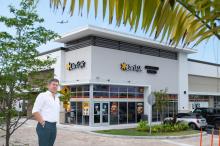A few weeks before leaving his current position, the General Manager for Latin America reviews with AméricaEconomía the main achievements of the open source firm for 2024 and the market's concerns.
2024 has been a year of strong results for Red Hat. Its parent company, IBM, reported US$15 billion in revenue in the third quarter, equivalent to a 10% increase in software revenue and a 14% growth in the company's own results.
Within this framework, Paulo Bonucci, Senior Vice President & General Manager for Red Hat Latin America for eleven years, knows that the company from North Carolina has been in the region for almost two decades, growing above the industry average.
“We are moving forward and gaining market share in our technology infrastructure services space,” Bonucci told AméricaEconomía .
Constantly moving around the region he oversees, Bonucci goes from one country to another to get closer to the local teams. “That’s what I call understanding how people are in the field, and you get that through direct interaction, not through a video or an email,” he says.
For this general manager, this direct contact in each country is also an important thermometer to measure the health of each market. “To know if customers are satisfied, if we have opportunities to grow, to understand how each country is behaving,” he adds.
Bonucci He knows that 2024 is on track to close positively with all the objectives of the firm, which arrived in Latin America in 2006, being achieved. “For our clients, our ability to offer the hybrid cloud in the multicloud strategy is increasingly relevant , so that they have total flexibility, freedom and cost efficiency to move workloads and develop new cloud-ready applications ,” he says.
This good performance has been driven mainly by Argentina, Brazil and Mexico, “But throughout Latin America, the average ticket for business with clients has grown between 20% and 30%, a sign that they are expanding their business IT and using a wider range of Red Hat solutions in their environments,” he proudly confirms.
According to data published by the company in October, this increase is recorded in all segments, and in key sectors such as finance, public and telecommunications, as well as services and retail .
In terms of revenue, Red Hat's three main platforms—Red Hat Ansible Automation Platform (automation), Red Hat Enterprise Linux (operating system), and Red Hat OpenShift (Kubernetes strategy)—are fairly balanced, with slightly more opportunity in automation.
While the areas that are growing the most from the point of view of opportunities are artificial intelligence and virtualization.
“One of the highlights of this year has been the evolution of our partner and alliance program, which has allowed us to be closer to hyperscalers such as AWS, Microsoft and Google, as well as IBM, which is of course our great partner. We have also been closer to system integrators, such as Logicalis and Accenture. This partnership allows Red Hat to have a much more complete and comprehensive offering to deliver value to our clients,” describes the executive.
PLATFORMS FOR BUSINESS
Since its inception in 1993, Red Hat has been built on open source.
“We are a 100% open source company : a technology development model through collaboration, where there is an unlimited number of engineers, universities, companies, communities, individuals, collaborating on the development of a project,” explains Bonucci.
With no copyright or intellectual property behind it, the Red Hat model then becomes the ability to move fluidly around the best technological solutions, with communities, individuals and companies.
With this premise, the firm mainly builds platforms for businesses to function. “We have a multi-cloud platform, so that companies can 'run' their systems (…) And the third platform is the automation platform, that is, we help clients with the technological complexity of their resources,” summarizes the general manager for Latin America.
That is the value that IBM saw in Red Hat and led to its acquisition in 2019. “So, we offer the client a whole universe of possibilities around that secure software ,” says Bonucci.
This way of collaborating and working is what also enables innovation, according to the executive.
“If I come up with something and I’m building it here, I contribute it to the community. Red Hat participates in that community, but it also makes a product cut that makes sense to be part of our infrastructure, Red Hat Enterprise Linux. And Red Hat provides the enterprise and security environment necessary for it to be used by companies, governments, and customers. So, that open source community model is what Red Hat does very well and what also allows it to foster innovation and secure software.
From the customers' point of view, they are asking for operational efficiency, seeking the best possibilities to save more and increase the value of their investments.
“We have moved from time to market to speed to market, which determines how quickly you can offer a service to your client or end consumer. And this is a huge advantage for Red Hat, because we have this platform to develop applications in an agile way. So, the first objective I say for operational efficiency and automation is, fundamentally, budget and also uptime.”
Regarding the expectations of customers from the company, the executive adds: “Innovation. Many of these customers look to Red Hat for its ability to innovate more quickly. That is the point of B2B. It is about innovating, innovating in two ways: rewriting legacy systems or applications that were not appropriate for a cloud concept. Then, we modernize them. Or writing applications that are already appropriate for the cloud world.”
In his view, security is also an increasingly recurring issue on the agenda of CEOs and CTOs. “In Brazil, there are about five thousand attempts at electronic fraud and cyber attacks per hour. So, companies, banks, governments are very concerned about the security of their information and assets. And Red Hat has a very important role in this, because being open source we also have many collaborators, engineers, partners, communities, working on the security of these systems.”
The fourth major issue that Red Hat faces in the business environment is predictive and generative artificial intelligence for the business-to-business world . “And we are also there, offering services and solutions suitable for this market with artificial intelligence models that run on top of our automation platforms, operating system and microservices, multi-cloud, hybrid cloud.”
THE OPTIMISTIC FUTURE
Although Bonucci does not want to be an exaggerated optimist, he believes that the business and government environment in Latin America will continue to be very attractive for Red Hat's growth: “The truth is that it is still a very dynamic world, with many uncertainties. The pandemic taught us the ability to react, whether it is a global or local event, companies must be agile.”
“Given the uncertainties that affect individuals and companies, it is necessary to approach them with resilience and reinvent ourselves, because [things like] quantum computing already exist, and they will arrive. And when they do, they will also need a platform, and although we do not offer quantum computing for the hardware or the software , the platform for these models to run will surely be ours,” he predicts.
For now, becoming a leader in AI and growing in virtualization are Red Hat's main focuses for 2025 worldwide, and it will be no different for Latin America, Bonucci warns.
“We are also investing heavily in security and automation solutions, where we see two important areas for business expansion.”
But this momentum for the coming year will be developed by Gilson Magalhães, who was until a few weeks ago the country manager in Brazil, who has been named the new general manager for the region. After years in leadership positions at companies such as Accenture, Oracle and Unisys, Paulo Bonucci leaves Red Hat on December 31, with a sense of duty accomplished and with the enthusiasm to devote himself to personal projects.
“Red Hat will continue to grow from strength to strength and offer high-value solutions and services to all Latin American customers. This is the result of the collective effort of a team that is passionate about what it does,” he concludes.









